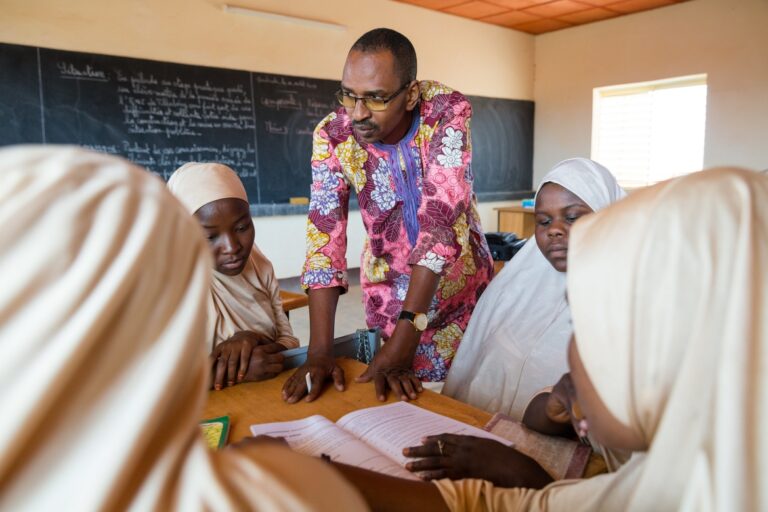Opinion: Helen Abadzi,
Greek psychologist, researcher at the University of Texas at Arlington.
On a recent flight, I sat next to a 3-year old Korean boy, who was watching a cartoon video on a tablet. Two characters were hitting each other. Every time one struck the other, the boy cried out with pleasure and slapped the seat with his hand. Clearly he was learning something that engaged the emotional areas of his brain. What was he learning, and how will he use it later?
“Boys always engaged in mischief; but organised bullying and attacks have multiplied in recent years”
It was in a primary school a few months later where the learning outcome came. It was at a boys’ middle-class school in the Middle East. First graders lined up to go to lunch. Suddenly one boy pushed another onto a line of students who all fell down. They started screaming. Two boys stepped aside and started kicking each other with the skill of a Kung Fu master, while the teacher was trying to impose some discipline with a voice hoarse from constant shouting. These were just two events in the course of 5 minutes. Just up the stairs, a group of third graders were pulling the hair of a short first grader who ran into the library crying. The boys waited outside for him, until a cousin came by and rescued him.
Was the school climate like this ten years ago? The older teachers emphatically said no. Boys always engaged in mischief; but organised bullying and attacks have multiplied in recent years. Teachers would stop one fight, and another one would start. Windows rattled, desks overturned. Some would jump on tables, scream, and ignore the teacher. When alone, individual boys would behave peacefully, but in a group, they paralysed the class. Those who wanted to study were deprived of opportunity.

Evolutionary psychology research shows that through play children practice the skills they will use later in life and also establish hierarchies of ability. Children are experts at imitating sequences, such as the steps of a dance, and compiling them into fluent sequences. The acts are not random. Millions of years ago some animals survived because they could learn from their peers. Watch-and-imitate sequences form the rudiments of education and are common among mammals, including ants. The animals that learned most efficiently left more descendants, and they passed learning abilities to their next generation.
Specialised neurons in the brain, sometimes called mirror neurons, have evolved to facilitate learning of movements. The imitation is not exact but adapts to circumstances. This constitutes informal education; unlike formal education, it takes place at all hours. We watch and perform the movements of the majority and of the role we expect to have in the future.
Aggressive acts seem easy to imitate. This was demonstrated in the United States in the 1960s1. Children watched a TV character hit a big doll, and later they were put in a room with that same doll. They were more likely to hit the doll than children who had not watched the video. Many studies since then have had similar results (see references on page 15). A 2017 study demonstrated that children who were shown guns being used in movies found guns in a toy room and used them. Those who had not been shown guns in movies, used them at a much lower rate2. The emotional connections facilitate consolidation. Once a child learns to hit a doll or joyfully imitate aggressive cartoons, it is unclear what forces will mitigate it.

The predilection for copying aggressive acts may be due to evolutionary forces on male roles. Humans have survived the harsh Paleolithic circumstances through labour division. Women bore and raised children, while men coalesced in groups to defend the community territory or to attack other groups and expropriate their wealth. Attack behaviours have been a key skill, and may be why boys practice it with each other. They also tend to find pleasure in explosions, racing police cars, blood, and weaponry.
The evolutionary adaptation to learn such skills creates interest, which the movie and video industry have exploited. Violence was produced since the movie industry started, but it was limited by technology and actions feasible by male adults. In the mid-20th century, violent movies featured cowboys and Indians, Kung Fu, or cartoons such as Roadrunner. But now technology has created digital characters and scenes that are only limited by the producers’ imagination. The feats of aggression and risk are now superhuman and not merely available for watching. They can be practiced in videogames. Children now practice car thefts, shoot aliens or ancient warriors or defend medieval castles. Violent content gets viewership and sells ads. It is almost impossible to turn on the television without finding a channel with a gun aimed at the viewer. The various media have thus brought this content perhaps to almost every child on the planet.
So, millions of boys such as the three-year old Korean receive individualised and efficient training on how to hit others, pick up guns, shout, threaten, take hostages, punish those who disobey. They watch characters who competently and instantly pull out weapons, often defending women who helplessly cry to be rescued. Children may watch 2-3 murders per minute, with fake blood flowing. And these training programmes run multiple times per day. A better training strategy to raise aggression would have been impossible to build.
The feats of aggression and risk are now superhuman and not merely available for watching. They can be practiced in videogames. Children now practice car thefts, shooting aliens or ancient warriors or defend medieval castles.
Compared with males who have not played violent video games, males who do play them are 67 per cent more likely to engage in non-violent deviant behavior, and 63 per cent more likely to commit a violent crime or a crime related to violence3. And like a canary in the mines, the effects of aggression training appear in the first grade.
Girls are affected in perverse ways. They may also become violent and kill girls they dislike, as some news stories show. But evolution has prepared women to look for strong defenders and providers. Thus many are attracted to violent men, even under risk of abuse. Men to some extent act violently because of female approval. And mating with aggressive males helps pass aggression-related traits to pass to the next generation. This tendency has gone on for thousands of years, but the many cases of girls who followed ISIS fighters to Syria bring this phenomenon into a sharp focus.
So what do researchers say today? Admittedly it is hard to attribute aggressive acts to movies watched long-ago, but links are clearly there. Violent content raises the probability of violent verbal encounters. It is not a coincidence perhaps that humans have been affected at the population level. There is an explosion of violence in the world. Men may not necessarily kill others, but they tend to become more verbally aggressive. They engage in bullying in schools, trolling on the internet, raping, harassing, and disparaging women. Desensitisation to suffering and death creates bizarre phenomena, such as a 17-year old girl coaching her boyfriend by phone to commit suicide.

There is a explosion of violence in the world. Billions are invested in violent media and videogames . . .
Thus there is an explosion of violent gangs, terrorism, mass murders, school shootings, multiple civil wars, cybercrime, threats between the US and North Korea. These suggest that aggressive actions start more easily now than 10-20 years ago. And the perpetrators know what to do. They use guns fluently and easily, and they teach their comrades the missing skills.
Many researchers have raised alarms and publicised study results. Even daily news featuring criminals generate additional events. But the only outcome is scientific publications and interesting editorials. Policymakers at the national or international levels are not giving much thought to this threat. It is easy to see why. Billions are invested in violent media and videogames, as well as in guns. Men are willing to pay for violent content, and companies are happy to profit. Thus, it is currently impossible to stop the training of the young.
In another decade, most adult males of the earth will have gone through the aggression training programmes. How will daily aggression levels change? No mitigating forces are visible at this time, and violence may rise further. Bands of aggressive men may drive women into retreat from the free movement and labour force participation that they have enjoyed since the 20th century. Wars may multiply and create larger areas of forced migration and environmental contamination. Devolution is conceivable in many areas, with humans driven back to the Paleolithic era that required aggressive adaptations. And with the changing climate and depleting natural resources, humans may be unable to climb out of that.
Justifiably, UNESCO is searching for counter-measures. UNESCO MGIEP is developing an online course on empathy, compassion, mindfulness and critical inquiry. But the effects of violent media are so instructional to the implicit memory system, that educational curricula are like a bandaid to a gunshot wound.
Somehow UNESCO must advocate for a ban of violent media. This certainly seems unrealistic and will not happen in the next decade. And even if new productions are banned, old movies and games will remain available in practically every corner of the world. Banning the content will only make it more desirable. And it may be insufficient to stop some children from being trained. They may just be more vulnerable to the bullies who have. There is a perverse reason to continue aggression training among all males.
So will our Paleolithic past control humanity’s future? UNESCO should become a voice of reason and science on human violence. It may initiate plans of action and obtain the buy-in of donors and influential governments.
In the 1920s, the independence of India seemed equally improbable. But Mahatma Gandhi, armed only with moral fortitude practiced non-violence and overcame impossible odds. Perhaps UNESCO MGIEP, with its scientific orientation to peace is the right institute for this task.
 Helen Abadzi is a Greek psychologist and polyglot of 19 languages. She retired after 27 years as a senior education specialist at the World Bank and is currently a researcher at the University of Texas at Arlington. To improve the outcomes of education investments, she regularly monitors research in cognitive psychology and neuroscience. The implications are often counterintuitive, suggesting that education can greatly improve by using the often little-known neurocognitive research. Dr. Abadzi writes articles, books, and blogs that integrate the research findings and offer solutions. She also lectures in various universities and is a frequent speaker in international conferences. Topics include learning methods, reading in multiple languages, numeracy, adult literacy and skills development, creativity, accountability, and others. Her publications are at http://uta.academia.edu/HelenAbadzi |
| 1Bandura, Albert; Ross, D.; Ross, S. (1963). “Imitation of film-mediated aggressive models”. Journal of Abnormal and Social Psychology. 66: 3–11. doi:10.1037/h00486872Christakis, D. A. & Rivara, F. P. (2017). Guns and Violent Media—A Toxic Mix With an Available Antidote. JAMA Pediatrics, September 25, 2017. doi:10.1001/ jamapediatrics.2017.2383
3Beck, V. S., Boys, S., Rose, C., & Beck, E. (2012). Violence against women in video games: A prequel or sequel to rape myth acceptance? Journal of interpersonal violence, 27(15), 3016-3031.
Sample of studies attesting to the effects of media violence AAlia-Klein, N., Wang, G. J., Preston-Campbell, R. N., Moeller, S. J., Parvaz, M. A., Zhu, W. & Fowler, J. S. (2014). Reactions to media violence: it’s in the brain of the beholder. PloS one, 9(9), e107260, doi:10.1371/journal.pone.0107260 Anderson, C. A., Shibuya, A., Ihori, N., Swing, E. L., Bushman, B. J., Sakamoto, A. & Saleem, M. (2010). Violent video game effects on aggression, empathy, and prosocial behavior in eastern and western countries: a meta-analytic review, doi: 10.1037/a0018251 Anderson, C. A., & Bushman, B. J. (2001). Effects of violent video games on aggressive behavior, aggressive cognition, aggressive affect, physiological arousal, and prosocial behavior: A meta-analytic review of the scientific literature. Psychological science, 12(5), 353-359, doi: 10.1111/1467-9280.00366 Anderson, C. A., Carnagey, N. L., Flanagan, M., Benjamin, A. J., Eubanks, J., & Valentine, J. C. (2004). Violent video games: Specific effects of violent content on aggressive thoughts and behavior. Advances in experimental social psychology, 36, 199-249. Andersen, K. (2017). Fantasyland: How America went haywire: A 500-year history. Random House. Bandura, A., Ross, D., & Ross, S. A. (1963). Imitation of film-mediated aggressive models. The Journal of Abnormal and Social Psychology, 66(1), 3, doi:10.1037/h0048687 Barash, D. P. (2014). Buddhist biology: Ancient Eastern wisdom meets modern Western science. Oxford University Press. Bartholow, B. D., & Anderson, C. A. (2002). Effects of violent video games on aggressive behavior: Potential sex differences. Journal of Experimental Social Psychology, 38(3), 283-290, doi:10.1006/jesp.2001.1502 Bavelier, D., Green, C. S., & Dye, M. W. (2010). Children, wired: For better and for worse. Neuron, 67(5), 692-701. Beck, V. S., Boys, S., Rose, C., & Beck, E. (2012). Violence against women in video games: A prequel or sequel to rape myth acceptance?. Journal of interpersonal violence, 27(15), 3016-3031, http://journals.sagepub.com/doi/abs/10.1177/0886260512441078 Bushman, B. J., & Anderson, C. A. (2009). Comfortably numb: Desensitizing effects of violent media on helping others. Psychological science, 20(3), 273-277. Bushman, B. J., & Anderson, C. A. (2001). Media violence and the American public: Scientific facts versus media misinformation. American Psychologist, 56(6-7), 477. Bushman, B. J., & Gibson, B. (2011). Violent video games cause an increase in aggression long after the game has been turned off. Social Psychological and Personality Science, 2(1), 29-32, doi: 10.1177/1948550610379506 Carnagey, N. L., Anderson, C. A., & Bushman, B. J. (2007). The effect of video game violence on physiological desensitization to real-life violence. Journal of experimental social psychology, 43(3), 489-496. Christakis, D. A., & Rivara, F. P. (2017). Guns and Violent Media—A Toxic Mix With an Available Antidote. JAMA pediatrics, 171(11), 1040-1041, doi:10.1001/jamapediatrics.2017.2383 Cikara, M., Jenkins, A. C., Dufour, N., & Saxe, R. (2014). Reduced self-referential neural response during intergroup competition predicts competitor harm. NeuroImage, 96, 36-43, doi: 10.1016/j.neuroimage.2014.03.080 Coyne, S. M., Stockdale, L., Linder, J. R., Nelson, D. A., Collier, K. M., & Essig, L. W. (2017). Pow! Boom! Kablam! Effects of viewing superhero programs on aggressive, prosocial, and defending behaviors in preschool children. Journal of abnormal child psychology, 1-13, doi: 10.1007/s10802-016-0253-6 Dillon, K. P., & Bushman, B. J. (2017). Effects of exposure to gun violence in movies on children’s interest in real guns. JAMA pediatrics, 171(11), 1057-1062, doi:10.1001/jamapediatrics.2017.2229 Engelhardt, C. R., Bartholow, B. D., Kerr, G. T., & Bushman, B. J. (2011). This is your brain on violent video games: Neural desensitization to violence predicts increased aggression following violent video game exposure. Journal of Experimental Social Psychology, 47(5), 1033-1036, doi: 10.1016/j.jesp.2011.03.027 Ewoldsen, D. R., Eno, C. A., Okdie, B. M., Velez, J. A., Guadagno, R. E., & DeCoster, J. (2012). Effect of playing violent video games cooperatively or competitively on subsequent cooperative behavior. Cyberpsychology, Behavior, and Social Networking, 15(5), 277-280, doi: 10.1089/cyber.2011.0308 Ferguson, C. J., Garza, A., Jerabeck, J., Ramos, R., & Galindo, M. (2013). Not worth the fuss after all? Cross-sectional and prospective data on violent video game influences on aggression, visuospatial cognition and mathematics ability in a sample of youth. Journal of youth and adolescence, 42(1), 109-122, doi:10.1007/s10964-012-9803-6 Furuya-Kanamori, L., & Doi, S. A. (2016). Angry birds, angry children, and angry meta-analysts: a reanalysis. Perspectives on psychological science, 11(3), 408-414, doi: 10.1177/1745691616635599 Fischer, P., Kastenmüller, A., & Greitemeyer, T. (2010). Media violence and the self: The impact of personalized gaming characters in aggressive video games on aggressive behavior. Journal of Experimental Social Psychology, 46(1), 192-195, doi: 10.1016/j. jesp.2009.06.010 Greitemeyer, T., & Mügge, D. O. (2014). Video games do affect social outcomes: A meta-analytic review of the effects of violent and prosocial video game play. Personality and Social Psychology Bulletin, 40(5), 578-589, doi: 10.1177/0146167213520459 Greitemeyer, T., & Osswald, S. (2010). Effects of prosocial video games on prosocial behavior. Journal of Personality and Social Psychology, 98, 211-221. Kelly, C. R., Grinband, J., & Hirsch, J. (2007). Repeated exposure to media violence is associated with diminished response in an inhibitory frontolimbic network. PLoS One, 2(12), e1268, https://doi.org/10.1371/journal. pone.0001268. Li, L., Chen, R., & Chen, J. (2016). Playing action video games improves visuomotor control. Psychological science, 27(8), 1092-1108, doi: 10.1177/0956797616650300 Markey, P. M., & Markey, C. N. (2010). Vulnerability to violent video games: A review and integration of personality research. Review of General Psychology, 14 (2), 82-91, doi: 10.1037/a0019000 Przybylski, A. K., Deci, E. L., Rigby, C. S., & Ryan, R. M. (2014). Competence-impeding electronic games and players’ aggressive feelings, thoughts, and behaviors. Journal of personality and social psychology, 106(3), 441. Riva, P., Gabbiadini, A., Lauro, L. J. R., Andrighetto, L., Volpato, C., & Bushman, B. J. (2017). Neuromodulation can reduce aggressive behavior elicited by violent video games. Cognitive, Affective, & Behavioral Neuroscience, 17(2), 452-459, doi:10.3758/s13415-016-0490-8 Robertson, L. A., McAnally, H. M., & Hancox, R. J. (2013). Childhood and adolescent television viewing and antisocial behavior in early adulthood. Pediatrics, 131(3), 439-446, doi: 10.1542/peds.2012-1582 Rusch, H., Leunissen, J. M., & van Vugt, M. (2015). Historical and experimental evidence of sexual selection for war heroism. Evolution and Human Behavior, 36(5), 367-373, doi: 10.1016/j.evolhumbehav.2015.02.005 Swann Jr, W. B., & Buhrmester, M. D. (2015). Identity fusion. Current Directions in Psychological Science, 24(1), 52-57, doi: 10.1177/0963721414551363 cdps.sagepub.com Towers, S., Gomez-Lievano, A., Khan, M., Mubayi, A., & Castillo-Chavez, C. (2015). Contagion in mass killings and school shootings. PLoS one, 10(7), e0117259, https://doi.org/10.1371/journal.pone.0117259 Van den Bulck, J. Çetin, J., Terzi, Ö., & Bushman,B. J. (2016). Violence, Sex, and Dreams: Violent andSexual Media Content Infiltrate Our Dreams at Night.Dreaming, 2016, doi: 10.1037/drm0000036 Willoughby, T., Adachi, P. J., & Good, M. (2012). A longitudinal study of the association between violent video game play and aggression among adolescents. Developmental psychology, 48(4), 1044.
Blogs and review articles on the effects of media violence http://www.dana.org/Cerebrum/2009/Video_Games_Affect_the_Brain%E2%80%94for_Better_and_Worse/ www.educationalneuroscience.org.uk/neuromyth-or-neurofact/violent-video-games-make-children-more-violent/ https://www.theguardian.com/science/head-quarters/2015/apr/07/games-and-social-media-is-there-any-scientific-evidence-for-digital-neglect https://aeon.co/ideas/how-video-games-unwittingly-train-the-brain-to-justify-killing http://public.psych.iastate.edu/caa/abstracts/2000-2004/01ba.ap.pdf https://www.psychologytoday.com/blog/pop-psych/201610/violence-in-games-does-not-cause-real-life-violence http://www.apa.org/pi/families/review-video-games.pdf http://www.apa.org/science/about/psa/2003/10/anderson.aspx |






